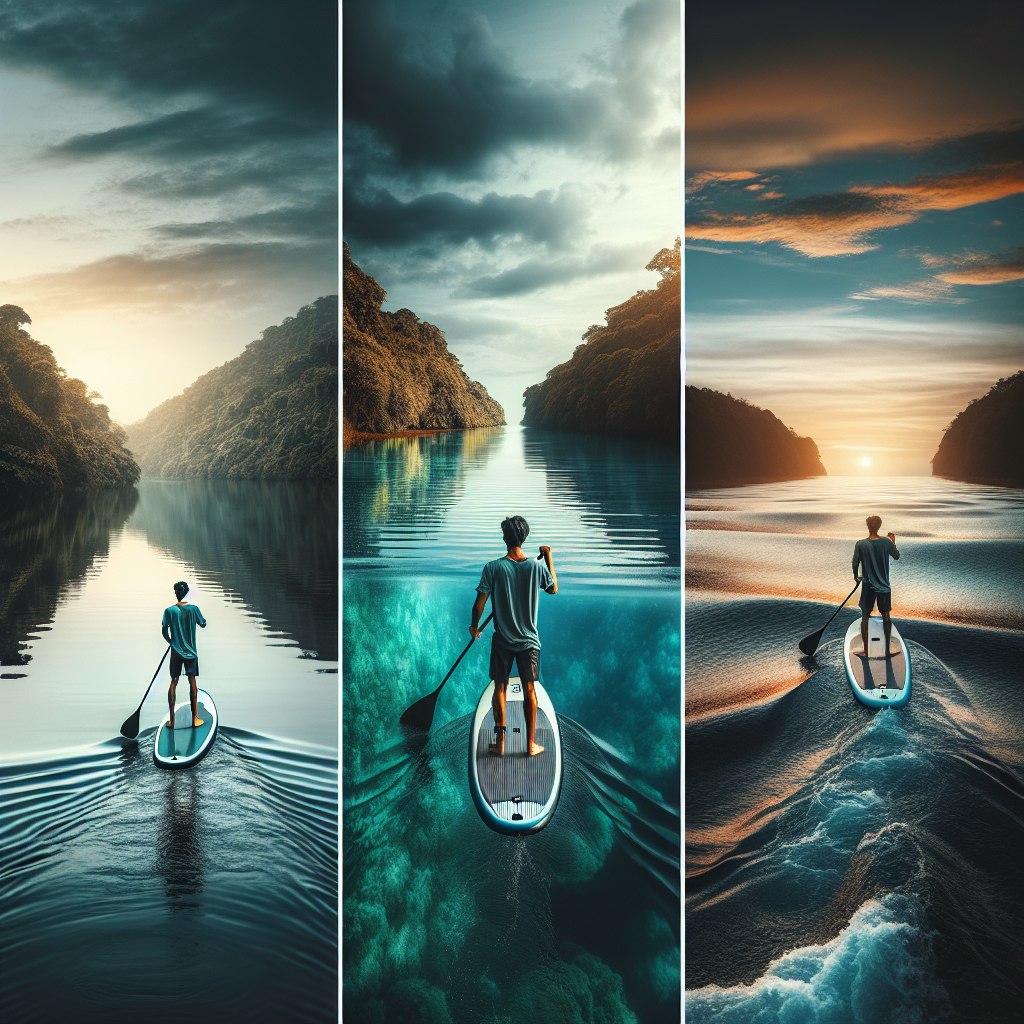Whether you’re a seasoned paddleboarder or just discovering this popular water sport, exploring various bodies of water can add a thrilling dimension to your paddleboarding experience. “Paddle Boarding in Different Waters: Lakes, Rivers, and Oceans” provides an immersive guide on how to enjoy this activity across varying water environments. From the serene majesty of lakes, the dynamic flow of rivers, to the vast expanse of oceans, this article offers valuable insights for a better, safer, and more enriching paddleboarding journey. So prepare to navigate and conquer different waters with your paddleboard!
Understanding the Basic Mechanics of Paddleboarding
Paddleboarding is a fun, engaging, and rewarding water activity that brings together fitness, balance, and the great outdoors. Understanding the basic mechanics is the key to success in paddleboarding.
Learning the proper stance
The correct paddleboarding stance involves placing your feet parallel, approximately hip-width distance apart, in the center of the board. Your toes should point forward, back straight, knees slightly bent and head and shoulders steady and upright.
Understanding paddle techniques
Effective paddle techniques involve using your entire body. When paddling, ensure you use your core muscles and not just your arms. The “power phase” of paddleboarding is all about pushing the paddle head down into the water and past your feet. Conversely, the “recovery phase” starts when you pull the paddle out of the water for another stroke.
Getting the balance right
Balance is key to successful paddleboarding. Stand up on the board with one foot slightly in front of the other – it might feel a little tipy at first, but you’ll quickly get the hang of it. Your feet should be about hip-width apart, centered between the edges of the board. Keep your knees slightly bent and your weight centred over your feet.
Safety Measures and Precautions While Paddleboarding
Like any sport, safety is paramount when paddleboarding.
Using the right gear
While paddleboarding, you should always wear a personal flotation device (PFD). Regardless of your swimming abilities, wearing a PFD can add an extra layer of safety, especially in deep water or in the instance of an unexpected fall.
Staying within your skill level
Secondly, always paddle within your capabilities. If you’re still a beginner, don’t venture into high traffic or extremely choppy waters. Similarly, if you’re not comfortable in tricky current conditions, it’s always safe to head close to the shore and paddle in calmer waters.
Importance of weather conditions
Lastly, be mindful of the weather. Wind and tide can swiftly change a calm paddleboarding session into a potentially dangerous situation, so always check the weather forecast before you hit the water.

Paddle Boarding in Lakes
Tranquil and serene, lakes can be a perfect setting for paddleboarding.
Identifying suitable lake terrains for paddleboarding
Several factors make a lake suitable for paddleboarding. Look for calm, clean water, easy launch sites, and less motorized boating traffic.
Calm condition and benefits to beginners
The calm waters of a lake can offer ideal conditions for beginners. These venues provide a relaxed environment, free from strong tides, waves and aquatic life, allowing beginners to focus on the basics such as balancing, steering and handling a paddleboard.
Safety rules and measures specific to lakes
While paddleboarding on lakes, make sure you’re aware of other water users, stick to designated areas away from reeds and other vegetation, and always tell someone where you’re going. Also ensure your carrying a whistle to alert others in case of danger or injury.
Tips and Techniques for Paddleboarding in Lakes
Paddleboarding on lakes differs in tactics and strategies than in rivers or oceans.
Optimizing paddle strokes for lake environment
In gentle lake conditions, the standard forward stroke is often enough. However, mastering several different types of strokes, such as the stroke-and-sweep technique or the draw-stroke, can help you maneuver more easily in whatever conditions you encounter.
Dealing with wind and other potential lake conditions
Sometimes, despite your best predictions, the wind can pick up on a lake and cause some small waves. Learning to counteract the effects of wind by adjusting your stance and stroke technique can hugely enhance your proficiency in paddleboarding.
Board choice for lakes
Flatwater paddleboards are usually best for lakes. These are often wider and longer, providing increased stability and smoothness across the water.

Paddle Boarding in Rivers
Rivers offer both a challenging and exhilarating paddleboarding experience.
Recognizing differences between river and lake paddleboarding
Unlike lakes, rivers often have currents, rapids, and other obstacles like rocks, branches, and debris. This means you have to be more aware of your surroundings and be prepared to react quickly.
Understanding river currents and their effect on paddleboarding
Currents can drastically impact your paddle boarding experience. A downstream current can make your journey easier, while an upstream current will make paddleboarding more challenging. Understanding the strength and direction of river currents is key to safely and effectively navigate rivers.
Safety measures specific to rivers
On rivers, always wear a helmet and consider knee and elbow pads. Beware of submerged hazards and strainers such as fallen trees. These can trap a paddler or their board, which could be catastrophic in fast flowing waters.
Tips and Techniques for Paddleboarding in Rivers
Your approach to paddleboarding in rivers involves understanding river features.
Learning river reading skills
Understanding how to read a river is vital. This includes recognizing features like rapids, eddies, and waves, identifying safe passages, and planning routes around potential hazards.
Managing swift currents and rapids
Learning how to manoeuvre a paddleboard in strong currents and rapids involves both strength and skill. It requires a solid understanding of techniques like ferrying (crossing a river), edging (turning the board using the edge), and bracing (keeping balance when in turbulent water).
Board choice for rivers
Inflatable paddleboards are often recommended for river environments. They are more durable and better able to withstand an impact with rocks or other obstacles you might encounter in a river.
Paddle Boarding in Oceans
Ocean paddleboarding demands a high level of skill, but also provides an exhilarating experience.
Understanding how tides, waves and oceanic winds affect paddle boarding
Paddleboarding in the ocean involves dealing with elements such as tides, waves, and herculean winds. Recognising the effect of these elements increase your chances of a successful and enjoyable paddleboarding session.
Safety precautions and measures specific to oceans
When paddleboarding in the ocean, always watch out for rip currents, avoid paddleboarding alone, and be considerate of surfers and swimmers. It’s also a good idea to learn about local marine wildlife and how to react if you encounter them.
Challenges and thrill of paddleboarding in the ocean
Despite the challenges, ocean paddleboarding can be incredibly thrilling. Conquering big waves, navigating around marine life, and even surfing breaking waves, all add to the excitement of ocean paddleboarding.
Tips and Techniques for Paddleboarding in Oceans
Paddleboarding on oceans requires a different set of tips and techniques.
Mastering techniques for dealing with waves
Learning how to negotiate waves is a necessary skill for ocean paddleboarding. This means understanding how to paddle onto a wave, when to stand up, and how to maintain balance once you’re riding it.
Navigating ocean wildlife
Sea life can pose both a fascinating and daunting aspect. Research the local wildlife, be respectful, and give creatures their space. If you are unsure how to respond to marine animals, take guidance from local experts or conservation groups.
Board choice for oceans
Choosing a board for ocean paddleboarding largely depends on what you want to do. Shorter boards are great for surfing waves, while longer boards can be better for distance paddling or downwinders.
Paddle Boarding Equipment for Different Water Types
Choosing the right equipment can make a big difference to your paddleboarding experience.
Choosing the correct paddle for each water type
A paddle is more than just your propulsion on the water – it’s your connection to the experience! Therefore, you want to choose the right paddle for your activity. For calm waters like lakes, a lighter paddle is sufficient. For choppy seas or fast rivers, you may want to go for a heavier, more durable model.
Life vests and safety gear
Regardless of the body of water you are paddling on, a good quality life vest is essential. Safety leashes are also important, as they keep you connected to your board if you fall off, while a safety whistle can alert others if you find yourself in trouble.
Pointers to consider when buying or renting a paddle board
Before purchasing or renting a paddleboard, consider factors like the type of water you’ll be paddling on, your skill level, and your weight and height. It’s also helpful to read reviews or get advice from seasoned paddleboarders or retailers.
Further Enhancing Your Paddleboarding Skill-set
Paddleboarding is a sport where there’s always room for improvement.
Training and lessons
Getting some professional training or lessons can dramatically enhance your paddleboarding skills. Not only will you learn new techniques, but you’ll receive personalised feedback on your stance, stroke, and balance.
Participating in paddleboarding communities
Joining local paddleboarding clubs or online communities is a great way to make new friends, share experiences, get advice, and even organize group trips.
Upcoming trends in paddleboarding
As with all sports, paddleboarding continues to evolve and improve. Try to keep up with trends like inflatable boards, or innovative techniques like SUP yoga or paddleboarding with pets. Who knows, they might just inspire a whole new paddleboarding adventure!
Remember, whether you are paddleboarding on a lake, a river or the ocean, the most important thing is to always stay safe and enjoy the experience. Happy paddleboarding!

